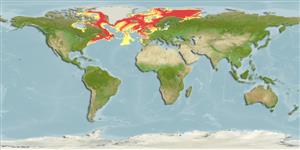Ελασμοβράγχιοι (καρχαρίες και σαλάχια) (sharks and rays) >
Squaliformes (Sleeper and dogfish sharks) >
Somniosidae (Sleeper sharks)
Etymology: Somniosus: Latin for sleepy, reflecting Lesueur’s surmise that these sharks are slow or sluggish because of their relatively small fins (hence the name sleeper sharks) (See ETYFish); microcephalus: micro-, from mikros (Gr.), small; cephalus, from kephale (Gr.), head, allusion not explained, perhaps referring to its short, rounded snout compared with other sharks then included in the catch-all genus Squalus (See ETYFish).
More on authors: Bloch & Schneider.
Environment: milieu / climate zone / depth range / distribution range
Οικολογία
Θαλασσινό(ά) βενθοπελαγικό; ωκεανόδρομο(ς) (Ref. 119696); εύρος βάθους 0 - 2992 m (Ref. 119696), usually 200 - 600 m (Ref. 35388). Boreal; -2°C - 17°C (Ref. 119696); 83°N - 27°N, 95°W - 61°E
Arctic and North and Central Atlantic: Canadian Arctic at Resolute Bay to Baffin Bay, southward in western Atlantic to Cape Cod and Georgia USA, eastward to Greenland, Iceland, Arctic Ocean off Svalbard and Franz Josef Land, and the Barents and White Seas southward in the eastern Atlantic to the Kattegat and west of Ireland and Canary Islands; rare records known farther south as well as in the Arctic..
Length at first maturity / Μέγεθος / Βάρος / Age
Maturity: Lm 335.5, range 244 - 427 cm
Max length : 427 cm TL αρσενικό/απροσδιόριστο; (Ref. 247); 550.0 cm TL (female); μεγ. δημοσιευμένο βάρος: 0.00 g; μεγ. αναφερόμενη ηλικία: 392 έτη (Ref. 110949)
Ραχιαίες άκανθες (συνολικά) : 0; Εδρικές άκανθες: 0; Σπόνδυλοι: 41 - 44. A gigantic, heavily-bodied dogfish shark with a moderately long, rounded snout and small, low dorsal fins; lower caudal lobe long; upper jaw with small single-cusped teeth and lower jaw with moderate-sized, bent-cusped, slicing teeth (Ref. 5578). Medium grey or brown in color, sometimes with transverse dark bands or small light spots (Ref. 5578).
Found on continental and insular shelves and upper slopes down to at least 1,200 m (Ref. 247) and to as deep as 2,200 m (Ref. 55584). Epibenthic-pelagic (Ref. 58426). In the Arctic and boreal Atlantic, it occurs inshore in the intertidal and at the surface in shallow bays and river mouths during colder months, retreating to depths of 180-550 m when the temperature rises (Ref. 247). Reported to be found in temperatures from -1.8° to 17.2°C but commonly below 5°C at with salinity range of 29.4-35.5. It is capable of undertaking long migrations (Ref. 119696). Feeds on pelagic and bottom fishes (herring, Atlantic salmon, Arctic char, capelin, redfish, sculpins, lumpfish, cod, haddock, Atlantic halibut, Greenland halibut and skates (Ref.
5951)), sharks and skates (Ref. 5578), seals and small cetaceans, sea birds, squids, crabs, amphipods, marine snails, brittle stars, sea urchins, and jellyfish (Ref. 247, 58240). Radiocarbon dating of eye lens nuclei from 28 caught female Greenland sharks (81-502 cm TL) revealed a life span of at least 272 years, the oldest being nearly 400 years; age of sexual maturity is about 150 years. This large species is slow-growing (Ref. 110949).
Petromyzon marinus was reported to have been attached to S. microcephalus (Ref. 58185). Ovoviviparous (Ref. 205). Utilized fresh and dried for human and sled-dog food (flesh is said to be toxic when fresh); Inuit also used the skin to make boots, and the
sharp lower dental bands as knives for cutting hair (Ref. 247). A very sluggish shark (Ref. 28609). Reports in literature of lengths exceeding 640 cm TL (e.g. up to 730 cm TL in Ref. 247) remain unverified. Common length 244-427 cm TL (Ref. 119696).
Ovoviviparous (Ref. 247). Distinct pairing with embrace (Ref. 205).
Yano, K., J.D. Stevens and L.J.V. Compagno, 2004. A review of the systematics of the sleeper shark genus Somniosus with redescriptions of Somniosus (Somniosus) antarcticus and Somniosus (Rhinoscymnus) longus (Squaliformes: Somniosidae). Ichthyol. Res. 51:360-373. (Ref. 50224)
IUCN Red List Status (Ref. 130435: Version 2024-1)
Threat to humans
Poisonous to eat (Ref. 4690)
Human uses
αλιεία: περιορισμένης εμπορικότητας; αλιεία αναψυχής: ναί
Εργαλεία
Special reports
Download XML
Διαδικτυακές πηγές
Estimates based on models
Preferred temperature (Ref.
123201): 0.6 - 9.3, mean 3.6 °C (based on 1058 cells).
Phylogenetic diversity index (Ref.
82804): PD
50 = 0.5313 [Uniqueness, from 0.5 = low to 2.0 = high].
Bayesian length-weight: a=0.00389 (0.00288 - 0.00525), b=3.16 (3.08 - 3.24), in cm total length, based on LWR estimates for this species (Ref.
93245).
Τροφικό Επίπεδο (Ref.
69278): 4.2 ±0.6 se; based on diet studies.
Generation time: 143.7 ( na - na) years. Estimated as median ln(3)/K based on 1
growth studies.
Ελαστικότητα (Ref.
120179): Πολύ χαμηλό, ελάχιστος χρόνος για διπλασιασμό πληθυσμού > 14 έτη (Fec=10; K=0.0075; assuming tm>10; tmax=392).
Fishing Vulnerability (Ref.
59153): Very high vulnerability (90 of 100).
Climate Vulnerability (Ref.
125649): Moderate to high vulnerability (50 of 100).
Nutrients (Ref.
124155): Calcium = 1.76 [0.30, 10.78] mg/100g; Iron = 0.163 [0.036, 0.621] mg/100g; Protein = 19 [16, 21] %; Omega3 = 0.24 [0.07, 0.83] g/100g; Selenium = 32.3 [7.0, 125.6] μg/100g; VitaminA = 10 [1, 76] μg/100g; Zinc = 0.321 [0.136, 0.690] mg/100g (wet weight);
